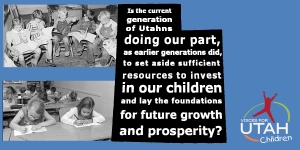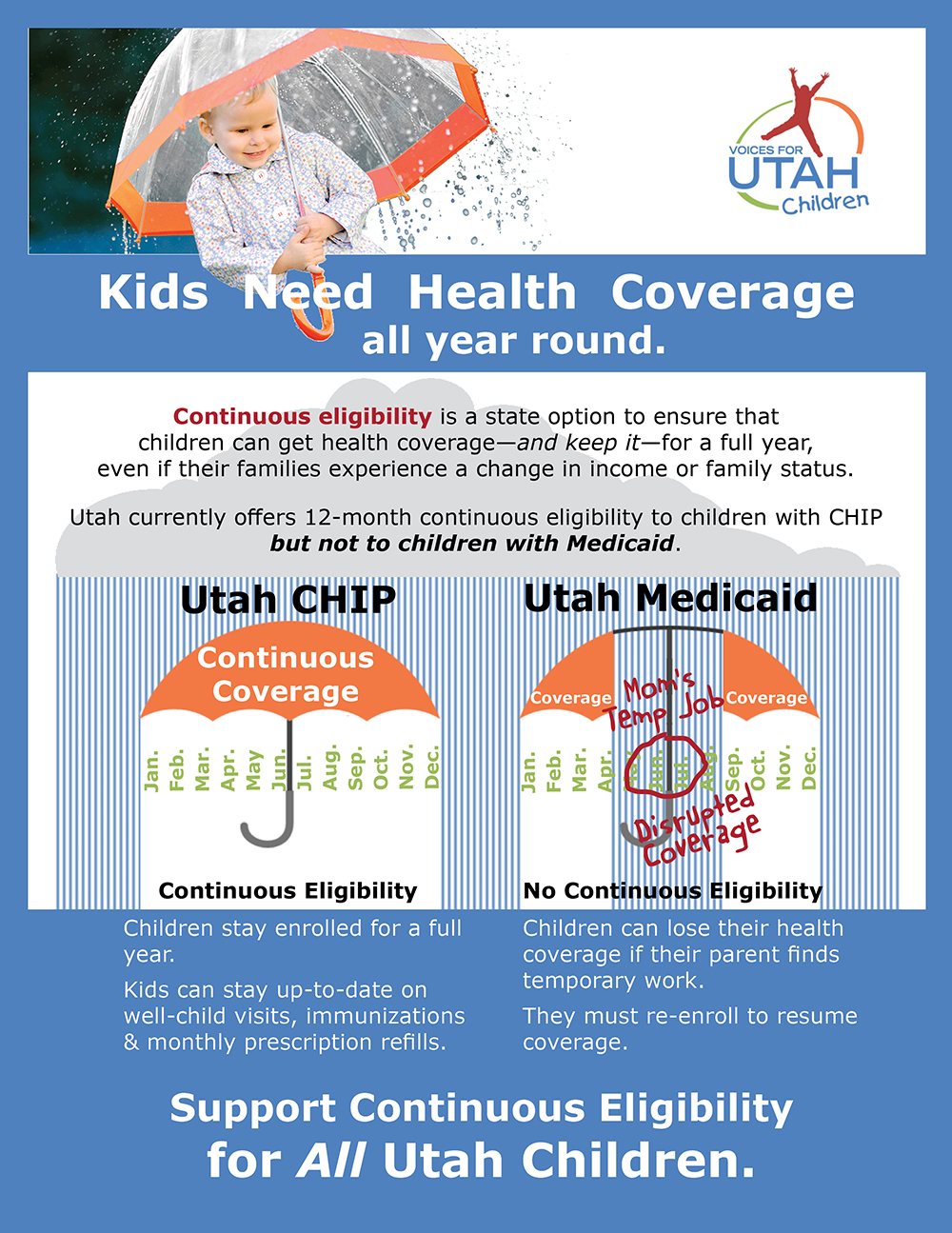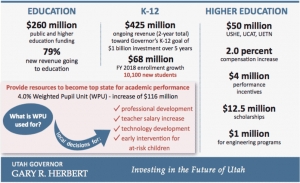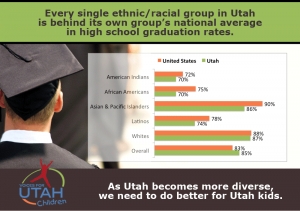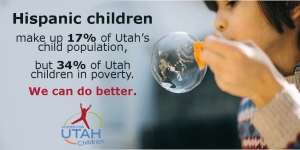State Policy
Creating a Targeted State Earned Income Tax Credit (EITC)
The federal Earned Income Tax Credit (EITC) lifts 60,000 Utahns out of poverty each year, half of them children, by letting low-income families keep more of what they earn.
EITC helps working families make ends meet.
EITC keeps families working.
EITC reduces poverty, especially among children.
EITC put $426 mil. back into Utah’s economy in 2017.
A state EITC targeted to families living in intergenerational poverty (IGP) will give a boost to the 25,000 working families who qualify for the federal EITC and file state taxes.
It will ensure that eligible working families receive 10% of federal EITC - up to $640 depending on income and number of children.
A state EITC may increase participation in the federal EITC. Only 75% of tax filers take advantage of the federal EITC
No bureaucracy or staff to administer.
FISCAL IMPACT
$6 million from General Fund which is a small portion of the over $25 million in state and local taxes paid every year by these working families.
Simply put, 58,820 children identified as living in intergenerational poverty amounts to $102 per child.
STATES WITH A STATE EITC
Twenty-nine states across the nation and political spectrum have created state EITCs.
EITC has strong bipartisan support
“… the proposed EITC helps people who are ready and able to help themselves escape intergenerational poverty through work…It is both sound economic policy and prudent welfare policy… It is good for those in poverty, good for the economy, and good for taxpayers as well.” Sutherland Institute
“I know of no public policy innovation over the past 30 years to help low-income individuals that has as much promise as Utah’s intergenerational poverty work. When combined with an EITC, Utah will be able to show the nation how public policies that are targeted, incentivize work, are fiscally constrained and include measurable outcomes are the best way to help families and children with great need.”
Natalie Gochnour
Associate Dean, David Eccles School of Business,
University of Utah, Deseret News column, March 1, 2018
For 30 years now, Voices for Utah Children has called on our state, federal and local leaders to put children’s needs first. But the work is not done. The children of 30 years ago now have children of their own. Too many of these children are growing up in poverty, without access to healthcare or quality educational opportunities.
How can you be involved?
Make a tax-deductible donation to Voices for Utah Children—or join our Network with a monthly donation of $20 or more. Network membership includes complimentary admission to Network events with food, socializing, and opportunity to meet child advocacy experts. And don't forget to join our listserv to stay informed!
We look forward to the future of Voices for Utah Children and we hope you will be a part of our next 30 years.
Special thanks to American Express, our "Making a Difference All Year Long" sponsor. 
Restoring Investment in Children
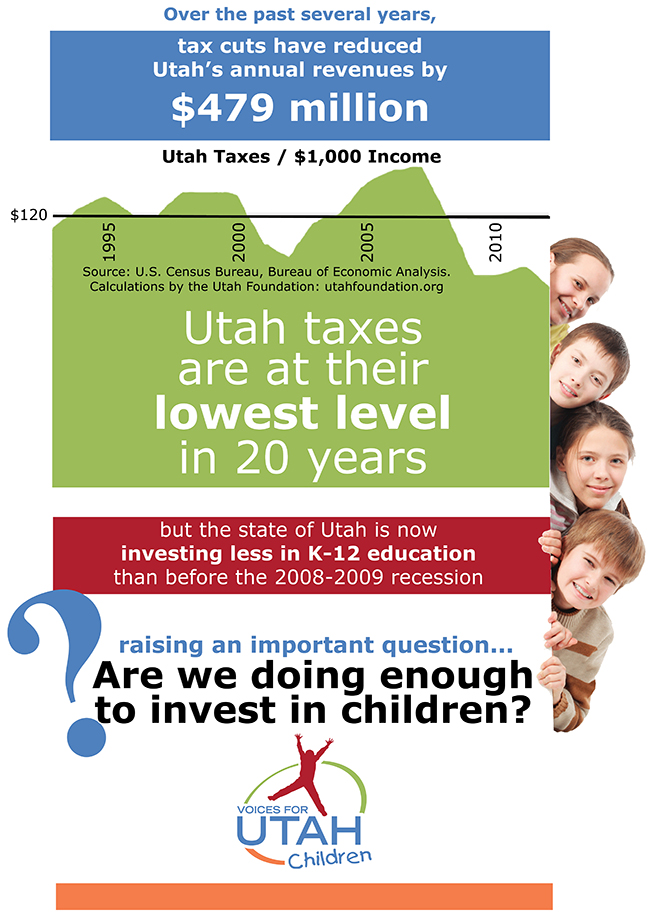 In January 2015, the Utah Foundation reported that Utah’s overall tax burden, including all state and local taxes and fees, had fallen to its lowest level in at least 20 years: “Over the past several years, tax cuts have reduced Utah’s annual revenues by $479 million.”
In January 2015, the Utah Foundation reported that Utah’s overall tax burden, including all state and local taxes and fees, had fallen to its lowest level in at least 20 years: “Over the past several years, tax cuts have reduced Utah’s annual revenues by $479 million.”
As a result, our investment in education remains well below pre-recession levels. Per-pupil state formula funding for K-12 education is down 11.9% from FY 2008 to 2017 (the current fiscal year). This 11.9% drop measures just the state contribution that constitutes two-thirds of our total public education budget. But the picture is no better when we look at the older data that include both state and local funding, which showed us seventh worst in the nation with a 17% drop in per-pupil expenditure for 2008-2014. The Voices for Utah Children's Utah Children’s Budget Report 2015 found that FY2014 real state spending per child remained 6% below pre-recession levels. Moreover, investment in K-12 education in particular has actually fallen in real terms since the 2008-2009 recession, before even accounting for the 7% growth in the number of children in Utah from FY2008 to FY2014.
While everyone enjoys paying lower taxes and having more dollars in our pockets today, these findings raise important questions about whether the current generation of Utahns is doing its part, as earlier generations did, to invest in our children and lay the foundations for Utah’s future growth and prosperity.
Moreover, recent data on high school graduation rates and college degrees raise warning signs that should concern all Utahns. Every racial and ethnic group in our state — including our two largest populations, whites and Hispanics — is below national averages for high school graduation rates. At the level of higher education, Utah’s share of college degrees among our younger generation has not kept up with the increases seen nationally.
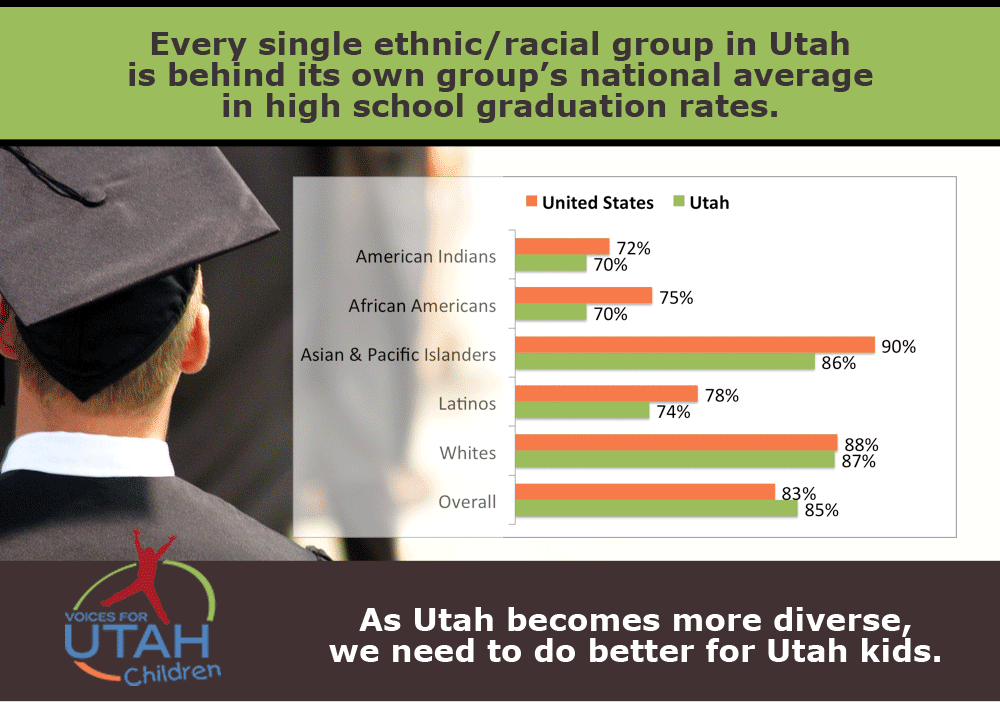
Opponents of new education revenues have for years counseled patience, assuring us that the economic boom that will generate new public education revenues is just around the corner or perhaps just another tax cut away. How long will we wait and watch our educational performance suffer — endangering our future prosperity — before taking seriously the challenge before us?
Printer-friendly Version:
![]() 2017 Children's Fiscal Policy Agenda
2017 Children's Fiscal Policy Agenda
More Information:
Utah Tax Reform Proposals: Who Wins and Who Loses?
Tax Reform and Utah's Most Vulnerable Populations
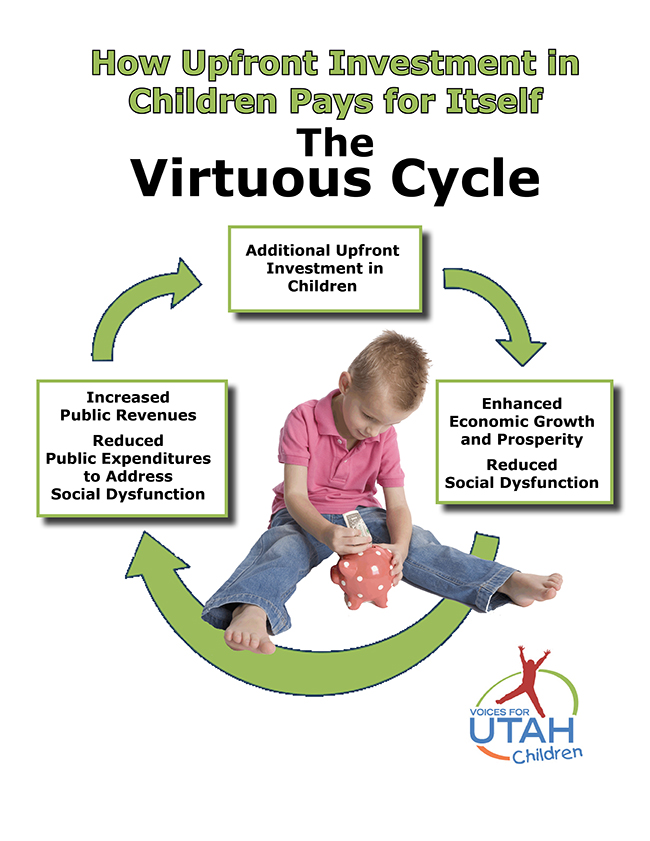
For 30 years now, Voices for Utah Children has called on our state, federal and local leaders to put children’s needs first. But the work is not done. The children of 30 years ago now have children of their own. Too many of these children are growing up in poverty, without access to healthcare or quality educational opportunities.
How can you be involved?
Make a tax-deductible donation to Voices for Utah Children—or join our Network with a monthly donation of $20 or more. Network membership includes complimentary admission to Network events with food, socializing, and opportunity to meet child advocacy experts. And don't forget to join our listserv to stay informed!
We look forward to the future of Voices for Utah Children and we hope you will be a part of our next 30 years.
Special thanks to American Express for sponsoring our 30th Anniversary Year. 
For 30 years now, Voices for Utah Children has called on our state, federal and local leaders to put children’s needs first. But the work is not done. The children of 30 years ago now have children of their own. Too many of these children are growing up in poverty, without access to healthcare or quality educational opportunities.
How can you be involved?
Make a tax-deductible donation to Voices for Utah Children—or join our Network with a monthly donation of $20 or more. Network membership includes complimentary admission to Network events with food, socializing, and opportunity to meet child advocacy experts. And don't forget to join our listserv to stay informed!
We look forward to the future of Voices for Utah Children and we hope you will be a part of our next 30 years.
Special thanks to American Express, our "Making a Difference All Year Long" sponsor. 
We'll count down the 2017 Utah Legislative Session with daily data about Utah kids.
 During the 2017 Legislative session, Utah lawmakers will be making decisions daily that will affect our state’s children and their families. At Voices for Utah Children, we know it’s important to make sure that decision makers have up-to-date, accurate, and accessible data to base their decisions on. That’s where our Utah KIDS COUNT Project comes in. Our annual “Measures of Child Well-Being” provides data on a variety of indicators at the county level.
During the 2017 Legislative session, Utah lawmakers will be making decisions daily that will affect our state’s children and their families. At Voices for Utah Children, we know it’s important to make sure that decision makers have up-to-date, accurate, and accessible data to base their decisions on. That’s where our Utah KIDS COUNT Project comes in. Our annual “Measures of Child Well-Being” provides data on a variety of indicators at the county level.
In addition, this year, the Utah KIDS COUNT project is proud to introduce our latest data product: a “page-a-day” countdown calendar! This daily electronic legislative calendar not only shares data, highlights programs, and policy solutions but also serves as a reminder of how many days are left in the legislative session to make a difference for kids. Please follow us @utchildren on twitter and like us on Facebook in order to get involved electronically as we count down the days in this year’s legislative session.
For 30 years now, Voices for Utah Children has called on our state, federal and local leaders to put children’s needs first. But the work is not done. The children of 30 years ago now have children of their own. Too many of these children are growing up in poverty, without access to healthcare or quality educational opportunities.
How can you be involved?
Make a tax-deductible donation to Voices for Utah Children—or join our Network with a monthly donation of $20 or more. Network membership includes complimentary admission to Network events with food, socializing, and opportunity to meet child advocacy experts. And don't forget to join our listserv to stay informed!
We look forward to the future of Voices for Utah Children and we hope you will be a part of our next 30 years.
Special thanks to American Express, our "Making a Difference All Year Long" sponsor. 
Support 12-Month Continuous Eligibility for Utah Kids with Medicaid
Utah FAQ’s
What is 12-month continuous eligibility for children on Medicaid?
Continuous eligibility is a state option that allows children, up through age 18, to maintain Medicaid coverage throughout the year, even if families experience a change in income or family status. By implementing continuous eligibility policies, a state ensures that for 365 days a year children get—and keep—health coverage.
What is churn?
“Churning” is when children are disenrolled in a public health insurance program and then re-enrolled after only a brief time without public insurance (2-6 months). “Churn” is the on-and-off-and-on pattern of enrollment that may be unrelated to actual eligibility status.
How does 12-month continuous eligibility affect families and children?
When children are enrolled in a program for 12 continuous months, they are less likely to lose their insurance coverage and more likely to experience continuity of care. In many cases, families must dis-enroll from Medicaid after securing unexpected temporary or seasonal work. When the short-term job ends, they must re-enroll in benefits. This creates an unnecessary burden for families. Parents are penalized for trying to improve their family’s economic circumstances through temporary or seasonal work.
How does 12-month continuous eligibility improve children’s health?
Children who have health insurance continuously throughout the year are more likely to have better health. Guaranteeing ongoing coverage ensures that children can receive appropriate preventive care, stay up to date on well-child visits and immunizations, fill their monthly prescriptions, and receive timely treatment for any health issues that arise. Stable coverage also enables providers to establish relationships with children and their parents and to track their health and development.
In contrast, when children experience gaps in health insurance coverage, they are less likely to have access to medical care. Interruptions in coverage can mean that children skip or delay a doctor’s visit or a prescriptions refill. People experiencing gaps in Medicaid coverage often experience serious health problems, while continuous Medicaid coverage is related to better health.
How will continuous eligibility help children with special health care needs?
According to Department of Health analysis, Medicaid children who are blind or disabled have one of the lowest average lengths of Medicaid eligiblity, compared to other eligibility categories. This suggests that children who are blind or disabled may be experiencing disruptions in care or coverage. A policy of 12-month continuous would allow all children, including those who are blind of disabled, to have continous health coverage.
How will continuous eligibility improve health plan accountability and value?
Continuous eligibility allows health plans to more accurately measure the quality of children’s health services and initiate program improvement strategies. Continuous eligibility improves health plan accountability. Health plans use a set of tools, called HEDIS measures (the Healthcare Effectiveness Data and Information Set), to assess their performance on health care and service. HEDIS measures require a one-year standard of continuous enrollment data. Children experiencing churn are not captured; HEDIS does not reflect the full make-up of children receiving care. Continuous eligibility leads to more comprehensive program improvement targets and better health care value for enrollees.
Why should Utah implement 12-month continuous eligibility now?
Despite declines in overall uninsured rates, Utah still has one of the highest rates of uninsured children in the nation. Continuous eligibility is a recognized best practice for states to lower their uninsured rate, improve program accountability and value, and assure vulnerable children get the best care.
Continuous eligibility helps retain children with low enrollment rates, including Hispanic children. Hispanic children are more likely to experience churn because of a change in their family’s temporary income status. At least 31% of Hispanic children have parents who lack year-round employment, compared to 18% of White children. Utah has the highest rate of uninsured Hispanic children in the nation. Programs that help children maintain continuous coverage, once they are enrolled, will reduce ethnic health disparities.
Health care leaders and officials urge states to adopt continuous eligibility as one of the top strategies to retain children in insurance programs and strengthen continuity of care.
12-month continuous eligibility is a critical way to make sure that Utah children have health insurance the entire year. All children should have access to health care without gaps or disruptions in coverage.
Printer-friendly Version:
![]() Support 12-Month Continuous Eligibility for Utah Kids with Medicaid
Support 12-Month Continuous Eligibility for Utah Kids with Medicaid
Photo Credit: © Talanis | Dreamstime.com - Family Under The Rain Photo
For 30 years now, Voices for Utah Children has called on our state, federal and local leaders to put children’s needs first. But the work is not done. The children of 30 years ago now have children of their own. Too many of these children are growing up in poverty, without access to healthcare or quality educational opportunities.
How can you be involved?
Make a tax-deductible donation to Voices for Utah Children—or join our Network with a monthly donation of $20 or more. Network membership includes complimentary admission to Network events with food, socializing, and opportunity to meet child advocacy experts. And don't forget to join our listserv to stay informed!
We look forward to the future of Voices for Utah Children and we hope you will be a part of our next 30 years.
Special thanks to American Express, our "Making a Difference All Year Long" sponsor. 
What We Like about Governor Herbert's New Budget Recommendations
Yesterday, Governor Herbert released his annual state budget recommendations.
The staff of Voices for Utah children found several reasons to be encouraged by his proposals.
We support the Governor and his team for their commitment to social services, and our most vulnerable children and families. Specifically, we applaud the Governor’s fiscally-prudent step to support family planning. This will have important benefits for families, including those in intergenerational poverty. With this investment, the state can expect to see savings by 2019. We thank the Governor for his leadership on this issue critical to children and families.
As an organization dedicated to helping all Utah children and families succeed, we believe that our social safety net provides a critical role to help families who have fallen on hard times get back on their feet. As noted in the Budget Recommendations, Utah has a “longstanding social fabric of self-determination.”
Our state budget priorities should support families’ ability to access and utilize public benefits in their time of need. Utah has the highest rate of children who are eligible for CHIP and Medicaid, but not enrolling in public programs. These children are uninsured and not able to benefit from health care services.
As the Governor declares, “the most effective programs, in terms of both quality outcomes and costs, prioritize preventative service delivery.” We strongly support the Governor’s focus. Health insurance coverage is the foundation to build successful prevention initiatives. We must strengthen and support our health insurance programs so that families and children can achieve their optimal health.
We are encouraged by the Governor’s recognition that early childhood is the cornerstone for lifelong learning. We support the Governor’s appropriation for the Baby Watch Early Intervention program as a critical first step. We look forward to seeing the Governor’s 10-year education plan, and hope the Governor will maintain his commitment to early childhood, so that we can establish a strong foundation for children’s healthy development, setting them up for success in school and beyond.
Voices for Utah Children welcomes Governor Herbert’s call in his FY2018 Budget Recommendations to conduct a comprehensive review of the state’s overall tax structure. In the section entitled “Taxation and a Free Market Economy” on page 9-12 (pages 13-16 of the pdf), there is an extended discussion of the trends and challenges facing Utah in terms of taxes and public revenues. The report highlights the downward trend in Utah’s overall level of taxation (including all state and local taxes and fees) and refers to the growing public sentiment that current revenues fall short of meeting the state’s minimum needs. The Governor declares his intention to address this pressing challenge with two concrete actions:
1. “the Governor will be establishing a task force of business leaders and education stakeholders to develop a comprehensive solution that aligns Utah’s tax structure with the modern economy (not just a rate increase), and
2. will request that the Tax Review Commission study and make recommendations regarding the state’s current tax structure, including alternatives for aligning the tax structure with the modern economy and identifying and reviewing tax credits, tax exemptions, tax exclusions, and other preferential tax loopholes.” (page 12)
The Governor and his team should be applauded for addressing these issues so thoughtfully and directly in the Budget Recommendations document and for his intent to convene further study and discussion about how to address this challenge going forward. In other states across the nation and across the political spectrum, the presence or absence of gubernatorial leadership has been a critical factor in determining whether states have been able to address their pressing challenges.
Voices for Utah Children has for a number of years raised the question of whether the current generation of Utahns is doing its part, as earlier generations did, to set aside sufficient resources each year to invest in the building blocks of our future growth and prosperity. Utah’s longstanding commitment to fiscal responsibility should extend beyond balanced budgets and strong bond ratings to also include taking responsibility for making the necessary investments today that reap benefits for future generations in the years and decades to come.
The complete document is available here:
Budget Recommendations Fiscal Year 2018
For 30 years now, Voices for Utah Children has called on our state, federal and local leaders to put children’s needs first. But the work is not done. The children of 30 years ago now have children of their own. Too many of these children are growing up in poverty, without access to healthcare or quality educational opportunities.
How can you be involved?
Make a tax-deductible donation to Voices for Utah Children—or join our Network with a monthly donation of $20 or more. Network membership includes complimentary admission to Network events with food, socializing, and opportunity to meet child advocacy experts. And don't forget to join our listserv to stay informed!
We look forward to the future of Voices for Utah Children and we hope you will be a part of our next 30 years.
Special thanks to American Express, our "Making a Difference All Year Long" sponsor. 
Voices for Utah Children Condemns Bullying in Utah Schools
At Voices for Utah Children, we firmly believe in and support the innate right of all people to live their lives free of harassment, intimidation, and fear. People of all races, ethnic backgrounds, religions, nationalities and sexual orientation help make Utah the vibrant and wonderful place it is. Our country has a history of oppression and violence toward marginalized people that we cannot deny and must oppose at every opportunity. Sadly, the rhetoric of the presidential campaign seems to have further emboldened those with discriminatory views. While they existed before the election season, recent reports of acts of hate and bigotry against children in schools and throughout our communities have rattled our sense of who we are as Utahns and Americans.
We applaud Governor Herbert and State Superintendent Dickson for their recent joint statement condemning harassment and bullying in Utah schools, and would ask that they, and community leaders across Utah, continue to take an active stand against any acts of hatred or bigotry committed in our state.
—The Board and Staff of Voices for Utah Children
For 30 years now, Voices for Utah Children has called on our state, federal and local leaders to put children’s needs first. But the work is not done. The children of 30 years ago now have children of their own. Too many of these children are growing up in poverty, without access to healthcare or quality educational opportunities.
How can you be involved?
Make a tax-deductible donation to Voices for Utah Children—or join our Network with a monthly donation of $20 or more. Network membership includes complimentary admission to Network events with food, socializing, and opportunity to meet child advocacy experts. And don't forget to join our listserv to stay informed!
We look forward to the future of Voices for Utah Children and we hope you will be a part of our next 30 years.
Special thanks to American Express, our "Making a Difference All Year Long" sponsor. 
Utah Education Is Falling Behind Nation and We Must Commit More Dollars
This op-ed by Voices for Utah Children State Priorities Partnership Director Matthew Weinstein originally appeared in the Salt Lake Tribune on October 29, 2016.
This month saw the publication of new state and federal data on high school graduation rates for the 2014-15 school year. "Utah high school graduation rate above average: 84.8 percent" crowed the headline of the Associated Press coverage carried in many Utah newspapers. But a closer look at the data reveals a more troubling picture.
 For the nation as a whole, high school graduation rates have been rising steadily in recent years. When broken out by race and ethnicity, the data show progress across the board, but also substantial disparities.
For the nation as a whole, high school graduation rates have been rising steadily in recent years. When broken out by race and ethnicity, the data show progress across the board, but also substantial disparities.
Here are the data for U.S. high school graduation rates in 2015: U.S. overall, 83.2 percent; whites, 87.6 percent; Latinos, 77.8 percent; Asian Americans/Pacific Islanders, 90.2 percent; African Americans, 74.6 percent; American Indians, 71.6 percent.
And here are the equivalent data for Utah in 2015: Utah overall, 84.8 percent; whites, 87.4 percent; Latinos 74.4 percent, Asian Americans/Pacific Islanders, 86.0 percent; African Americans, 70.0 percent; American Indians, 70.0 percent.
Two things stand out about these data:
1) Utah is ahead of the national average in the overall high school graduation rate.
2) Every single ethnic/racial group in Utah is behind its own group's national average, including our two largest populations, whites and Hispanics.
How is it possible that we are ahead of the national average overall but behind within each individual ethnic/racial group? The answer is simple math: we have a higher-than-average share of whites, who have a higher than average high school graduation rate. Utah's population is 79 percent non-Hispanic white, while the national average is 62 percent.
But should we be concerned that every racial/ethnic group in Utah is behind the national graduation rates for its own group? We should, for several reasons:
1) Regarding our white majority, these data should prompt us to ask: Why has the white population in Utah over the last few years been 0.2-0.6 points behind whites nationally? Could it be that even Utah's highest-in-the-nation level of two-parent families and high levels of parent volunteerism are not enough to overcome the detrimental effects of our lowest-in-the-nation level of per-pupil funding, even among the most economically secure segment of our population?
2) Our Hispanic minority is growing fast — now reaching 14 percent of the state's population — and 17 percent of our children. This means that Latinos are one-sixth of our future workforce. The fact that their graduation rate is 10.4 points behind the state average — and 3.4 points behind Latinos nationally — should be cause for very great concern.
3) Our two smallest minorities, African Americans and American Indians, together make up 3 percent of our population and fall 15 percentage points behind the state average for high school graduation rates, our largest disparity.
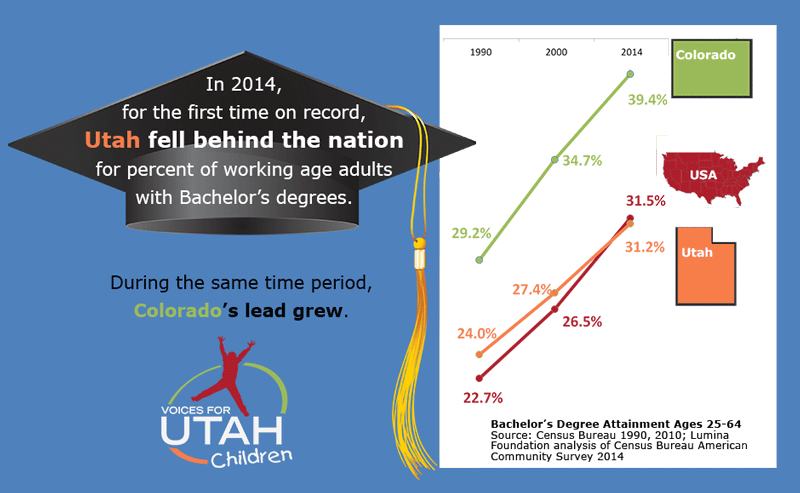 These alarming findings come just a few months after it was reported that Utah has now, for the first time on record, fallen behind the national average for college degrees (bachelor's degrees and higher among our working-age population ages 25-64). Taken together, these new data show Utah underperforming at both the high school and college levels, seriously weakening the case made by those who argue that new revenues are unnecessary because we achieve good results in spite of low investment.
These alarming findings come just a few months after it was reported that Utah has now, for the first time on record, fallen behind the national average for college degrees (bachelor's degrees and higher among our working-age population ages 25-64). Taken together, these new data show Utah underperforming at both the high school and college levels, seriously weakening the case made by those who argue that new revenues are unnecessary because we achieve good results in spite of low investment.
Following a decade of tax cutting, Utah's overall tax burden (including all state and local taxes and fees) is at a multi-decade low. Utah's sub-par educational performance raises an important question about whether the current generation of Utahns is doing its part, as earlier generations did, to set aside sufficient resources to invest in our children and lay the foundations for our future growth and prosperity. While raising taxes is rarely popular, any mom or dad will tell you that sometimes you have to eat your broccoli, whether you like it or not.
 On the topic of low investment, this month also saw the release of a new national report that found Utah ranks sixth worst in the nation for our drop in per-pupil state formula funding for K-12 education — down 11.9 percent from FY 2008 to 2017 (the current fiscal year). This 11.9 percent drop measures just the state contribution that constitutes two-thirds of our total public education budget. But the picture is no better when we look at the older data that include both state and local funding, which showed us seventh worst in the nation with a 17 percent drop in per-pupil expenditure for 2008-2014.
On the topic of low investment, this month also saw the release of a new national report that found Utah ranks sixth worst in the nation for our drop in per-pupil state formula funding for K-12 education — down 11.9 percent from FY 2008 to 2017 (the current fiscal year). This 11.9 percent drop measures just the state contribution that constitutes two-thirds of our total public education budget. But the picture is no better when we look at the older data that include both state and local funding, which showed us seventh worst in the nation with a 17 percent drop in per-pupil expenditure for 2008-2014.
Opponents of new education revenues have for years counseled patience. They have for years assured us that the economic boom that will generate new public education revenues is just around the corner or perhaps just another tax cut away. How long will we wait and watch our educational performance suffer — endangering our future prosperity — before taking seriously the challenge before us?
For 30 years now, Voices for Utah Children has called on our state, federal and local leaders to put children’s needs first. But the work is not done. The children of 30 years ago now have children of their own. Too many of these children are growing up in poverty, without access to healthcare or quality educational opportunities.
How can you be involved?
Make a tax-deductible donation to Voices for Utah Children—or join our Network with a monthly donation of $20 or more. Network membership includes complimentary admission to Network events with food, socializing, and opportunity to meet child advocacy experts. And don't forget to join our listserv to stay informed!
We look forward to the future of Voices for Utah Children and we hope you will be a part of our next 30 years.
Special thanks to American Express, our "Making a Difference All Year Long" sponsor. 
Utah above average – and below average – in new national high school graduation data
This week saw the publication of new state and federal data on high school graduation rates for the school year than ended in June 2015. “Utah high school graduation rate above average: 84.8 percent” crowed the headline of the AP coverage carried in many Utah newspapers. But a closer look at the data reveals a more troubling picture.
It is a well-known and highly distressing fact of American life that we suffer from tremendous disparities among our various racial and ethnic groups in many social and economic characteristics, including educational attainment. For the nation as a whole, here are the high school graduation rates trends over the past few years, broken out by race and ethnicity:

Now here are the equivalent data for Utah:

Two things about these data stand out:
1) Utah is ahead of the national average in the overall high school graduation rate. Bravo for us!
2) Every single ethnic/racial group in Utah is behind its own group’s national average, including our two largest groups, whites and Hispanics. Huh?
How is it possible that we are ahead of the national average overall but behind within each individual ethnic/racial group? The answer is simple math: we have a higher-than-average share of whites, who have a higher than average high school graduation rate. Utah’s population is 79% non-Hispanic white, while the national average is 62%. Thus, the fact that we have a higher share of a group with a higher graduation rate gives us an advantage in the overall high school graduation rate.
But should we be concerned that every racial/ethnic group in Utah is behind the national graduation rates for its own group? We should, for at least two reasons:
1) Inevitably we have to ask, why has the white population in Utah over the last few years been 0.2-0.6 points behind whites nationally? Could it be that even Utah’s highest-in-the-nation level of two-parent families and high levels of parent volunteerism are not enough to overcome the detrimental effects of our lowest-in-the-nation level of per-pupil funding, even among our white population? That would certainly appear to be the case.
2) Our Hispanic minority is growing fast – now reaching 14% of the state’s population -- and 17% of our children. This means that Latinos are one-sixth of our future workforce. The fact that their graduation rate is 10 points behind the state average – and 3.4 points behind Latinos nationally – should be cause for very great concern.
These alarming findings come just a few months after Voices for Utah Children reported that Utah has now, for the first time on record, fallen behind the national average for college degrees (Bachelor’s degrees and higher among our working-age population ages 25-64). Taken together, these developments should sound a red alert among our state’s policymakers.
Sources:
http://nces.ed.gov/ccd/tables/ACGR_RE_and_characteristics_2014-15.asp
http://nces.ed.gov/ccd/tables/ACGR_RE_and_characteristics_2013-14.asp
http://nces.ed.gov/ccd/tables/ACGR_RE_and_characteristics_2012-13.asp
For 30 years now, Voices for Utah Children has called on our state, federal and local leaders to put children’s needs first. But the work is not done. The children of 30 years ago now have children of their own. Too many of these children are growing up in poverty, without access to healthcare or quality educational opportunities.
How can you be involved?
Make a tax-deductible donation to Voices for Utah Children—or join our Network with a monthly donation of $20 or more. Network membership includes complimentary admission to Network events with food, socializing, and opportunity to meet child advocacy experts. And don't forget to join our listserv to stay informed!
We look forward to the future of Voices for Utah Children and we hope you will be a part of our next 30 years.
Special thanks to American Express, our "Making a Difference All Year Long" sponsor. 
New Video: The Utah Health Coverage Gap
This new 3-minute video, featuring Lincoln Nehring, President and CEO of Voices for Utah Children and policy experts at the Georgetown Center for Children and Families, describes the plight of Utah families in the healthcare coverage gap. In Utah, a single mom with two children must earn $756/month or less to qualify for Medicaid. "That is painfully low," points out Nehring. In most other states, a parent can earn triple that amount and still qualify.
Joan Alker of Georgetown lists three reasons Utah should expand access to coverage:
- A healthier parent is a better parent.
- Children are more likely to be insured if their parents are insured.
- The whole family must be insured to protect the family from medical debt and bankruptcy.
The good news? "States can expand Medicaid at any time—the sooner the better," says Nehring.
Utah Health Coverage Gap from Georgetown CCF on Vimeo.
For 30 years now, Voices for Utah Children has called on our state, federal and local leaders to put children’s needs first. But the work is not done. The children of 30 years ago now have children of their own. Too many of these children are growing up in poverty, without access to healthcare or quality educational opportunities.
How can you be involved?
Make a tax-deductible donation to Voices for Utah Children—or join our Network with a monthly donation of $20 or more. Network membership includes complimentary admission to Network events with food, socializing, and opportunity to meet child advocacy experts. And don't forget to join our listserv to stay informed!
We look forward to the future of Voices for Utah Children and we hope you will be a part of our next 30 years.
Special thanks to American Express, our "Making a Difference All Year Long" sponsor. 
Recent Census data show that Utah has made some improvements when it comes to reducing child poverty, but Utah Hispanic or Latino children are still disproportionately experiencing poverty, compared to their White peers.
Looking at the overall poverty rates, Utah children fare better than the rest of the United State, the so-called “Utah advantage”. But the gap between White children and Hispanic children in Utah is alarming: 25% of Hispanic children live in poverty, compared to 9% of White children.
The poverty rate for Utah Hispanic children declined in 2015, while the rate for Utah White children remained relatively stagnant. The poverty rate for Utah children overall stayed at 13%. Although the decline in poverty rates for Hispanic children is encouraging, the gap between White children and Hispanic children is still too wide.
Utah’s 2015 child poverty data underscore the need for an equity review of our programs and policies: Why are some racial and ethnic groups making progress, while other groups stagnate? How do we close the economic divide between Hispanic and White children?
Going forward, politicians and decision-makers need to look at the impact our policies have on children of all racial and ethnic groups, so we can strengthen what’s working and re-evaluate what’s not.
For more information, see Income and Poverty in the United States: 2015.
A closer look at the numbers: Why only White and Hispanic children?
We are sharing child poverty data from the Census Bureau’s American Community Survey. For child poverty rates in Utah, unless multiple years of data are aggregated, statistically-significant Census findings are only available for the following racial and ethnic categories: non-Hispanic White, Hispanic or Latino, and 2 or more races. Unfortunately we do not have data available for all groups of children in our state. As recent Utah Department of Health Office of Heath Disparities reports highlight, disparities affect all children of color in our state. We need more child-specific data, disaggregated by race and ethnicity, so we can understand how policy decisions are affecting all groups of children in Utah.
For 30 years now, Voices for Utah Children has called on our state, federal and local leaders to put children’s needs first. But the work is not done. The children of 30 years ago now have children of their own. Too many of these children are growing up in poverty, without access to healthcare or quality educational opportunities.
How can you be involved?
Make a tax-deductible donation to Voices for Utah Children—or join our Network with a monthly donation of $20 or more. Network membership includes complimentary admission to Network events with food, socializing, and opportunity to meet child advocacy experts. And don't forget to join our listserv to stay informed!
We look forward to the future of Voices for Utah Children and we hope you will be a part of our next 30 years.
Special thanks to American Express, our "Making a Difference All Year Long" sponsor. 


